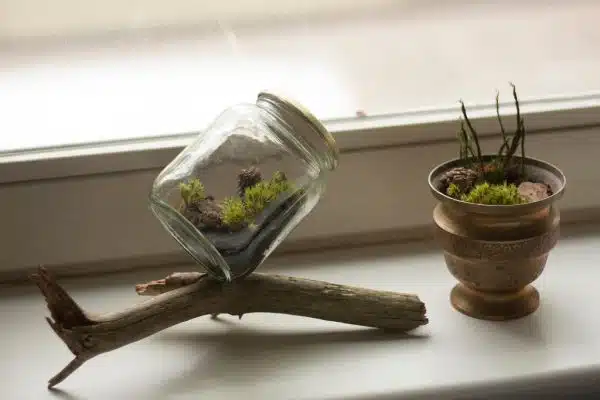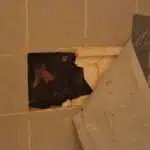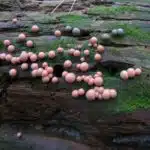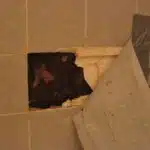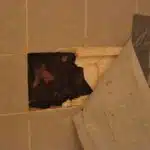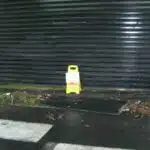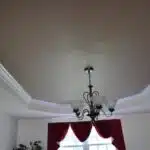Terrariums are an excellent way to bring a little bit of the outdoors inside. They are perfect for those who want to enhance their living space with greenery but don’t have much time or space to maintain a full garden. Terrariums are low maintenance, easy to care for, and can be customized to suit individual tastes and preferences. In this article, we will explore the basics of making a terrarium, including the materials needed, step-by-step instructions, and tips for creating a unique and beautiful display.
Creating a basic terrarium is not only an enjoyable DIY project but also an opportunity to learn about plant life and how it thrives in different environments. Whether you live in an apartment or have limited outdoor space, terrariums provide an easy way to incorporate plants into your home decor. The process of building a terrarium can be therapeutic and calming while also enhancing your surroundings. So if you’re looking for a simple and rewarding way to spruce up your living space, read on for our guide on how to make a basic terrarium that will add life and beauty to any room.
Understanding Terrariums And Their Benefits
Terrariums are miniature ecosystems that offer a variety of benefits. They are incredibly easy to care for and require very little maintenance, making them perfect for busy individuals who love plants but don’t have the time to tend to a full-sized garden. These self-contained environments can be used to grow a variety of plants from succulents and cacti to ferns and mosses.
One of the main benefits of owning a terrarium is that it helps improve indoor air quality by increasing oxygen levels while removing harmful toxins such as formaldehyde and benzene. Additionally, they are fantastic for adding a touch of greenery to any room in your home or office. Not only do they look great, but they also help reduce stress and anxiety levels by creating a calming environment.
Understanding and caring for your terrarium is essential if you want it to thrive. The key is finding the right balance between light, water, and soil conditions. Terrariums require minimal watering since they are essentially self-sustaining ecosystems with their own water cycle. Overwatering can lead to root rot, so it’s important not to water too frequently. By following these simple maintenance tips, you can ensure that your terrarium thrives for years to come.
When choosing the right container for your terrarium, it’s essential to consider its size and shape carefully. The container must be large enough to accommodate the plants’ roots while still leaving enough space for adequate airflow. Additionally, make sure that the container has drainage holes at the bottom or use gravel at the base of the container if there aren’t any holes. This helps prevent overwatering by allowing excess water to drain out of the container easily.
Choosing The Right Container For Your Terrarium
When it comes to creating a terrarium, choosing the right container is crucial. There are a variety of terrarium container ideas available, each with their own unique advantages and disadvantages. It’s important to consider both the aesthetic appeal and practicality of your chosen container.
One important consideration when selecting a terrarium container is size. The size of your container will determine how many plants you can include in your terrarium as well as how much soil and other materials you’ll need. Additionally, larger containers may be more difficult to transport or maneuver, so it’s important to consider where you plan to keep your terrarium before choosing a size.
Another factor to consider when selecting a container is the type of plants you plan to include in your terrarium. Certain plants require more space than others, so it’s important to choose a container that can accommodate the specific needs of your chosen plants. Additionally, some containers may be better suited for certain types of plants based on factors such as drainage and ventilation.
- Choose a container that allows for easy access for planting and maintenance.
- Consider using clear glass or plastic containers to showcase the contents inside.
- Don’t be afraid to get creative with unconventional containers such as teapots or light bulbs.
With so many options available, choosing the right container for your terrarium can feel overwhelming. However, by considering factors such as size and plant needs, you can narrow down your options and find the perfect vessel for your miniature garden. Next up: selecting the best plants for your terrarium!
Selecting The Best Plants For Your Terrarium
The beauty of a terrarium lies in the careful selection of the best plants to adorn it. Choosing appropriate greenery is vital for creating an enchanting little world within a glass container. The key is to pick plants that thrive in a humid and low-light environment.
One of the best terrarium plants is the fern. Ferns are low-maintenance and add a delicate touch to your miniature garden. Another great option is moss, which comes in different shades of green and adds texture and depth to your terrarium. Succulents, such as echeveria or haworthia, are also excellent choices as they require minimal watering and can thrive in small spaces.
When selecting the best plants for your terrarium, it is essential to consider their growth habits, size, and light requirements. Choose plants that complement each other in terms of color and texture, making sure not to overcrowd your container. With the right selection of greenery, you can create an aesthetically pleasing terrarium that will bring joy to those who see it. In preparing your terrarium for planting, it’s time to get creative with arranging the chosen plants into a harmonious arrangement within your glass enclosure – this will be discussed next!
Preparing Your Terrarium For Planting
- When selecting plants for your terrarium, consider the amount of light, air circulation, and humidity that the plants will need to thrive.
- When selecting soil, look for a soil mix that is lightweight and well-draining, as well as one that contains fertilizer and wetting agents.
- Consider adding drainage material to the bottom of the terrarium to ensure that excess moisture can escape.
- Before planting, water the soil so that it is evenly moist and make sure to leave space between the plants to allow for proper air circulation.
Choosing The Right Plants
When it comes to choosing the right plants for your terrarium, there are a few things to keep in mind. Plant compatibility is key when it comes to creating a healthy and thriving ecosystem inside your glass container. You want to choose plants that have similar environmental needs, such as light and moisture levels. Mixing plants with different requirements can lead to one plant dominating the others or even dying off altogether.
Maintenance tips are also important when selecting plants for your terrarium. Choose low-maintenance varieties that require minimal water and pruning, which will make keeping your terrarium looking beautiful much easier. Succulents and cacti are great options for beginners since they require little watering and can thrive in dry conditions. Ferns and mosses are also excellent choices since they prefer high humidity levels, making them well-suited for an enclosed environment like a terrarium.
In summary, choosing the right plants for your terrarium involves considering plant compatibility and maintenance tips. By selecting plants that have similar environmental needs and require minimal upkeep, you can create a beautiful and healthy ecosystem inside your glass container that will be easy to maintain over time. With these guidelines in mind, you’ll be well on your way to creating a stunning terrarium that will bring beauty into any space!
Selecting The Soil
Creating a terrarium is an excellent way to bring nature indoors and add a touch of greenery to any space. However, before you start planting, it’s important to prepare the right environment for your plants to thrive. One crucial aspect of preparing your terrarium is selecting the right soil. There are several types of soil that work well for terrariums, including potting soil, cactus mix, and peat moss. Each type has its own unique benefits and drawbacks, so it’s essential to choose the one that best fits your plant selection.
Potting soil is a popular choice for most terrariums since it’s relatively inexpensive and easy to find at any garden center or hardware store. It provides excellent drainage while retaining moisture, making it ideal for plants that require moderate watering. Cactus mix is another great option since it’s specifically designed for plants that need well-draining soil. This type of soil contains sand or perlite, which helps prevent water from accumulating in the bottom layer of your container.
While selecting the right type of soil is crucial when creating a terrarium, maintaining your soil is equally important. Over time, organic matter in the soil can break down and become compacted, leading to poor drainage and suffocating roots. To prevent this from happening, it’s important to regularly aerate your soil by gently stirring it with a fork or chopstick. You can also add fresh potting mix or vermiculite to improve drainage and nutrient content over time. With these tips in mind, you’ll be well on your way to creating a beautiful and healthy terrarium that will thrive for years to come!
Adding Soil And Other Substrates
Before adding soil to the terrarium, it is essential to add drainage. Without proper drainage, the soil will become waterlogged, leading to root rot and other plant diseases. A few ways to add drainage to your terrarium include using rocks or gravel at the bottom of the container or adding a layer of activated charcoal. Charcoal has excellent absorbent properties that help keep the soil fresh and free from toxins.
Choosing substrates for your terrarium is an important step in creating a healthy environment for your plants. The substrate is the material used as a growing medium for plants. There are several options available, including peat moss, coconut coir, sand, and vermiculite. When selecting a substrate, consider the specific needs of your plants. Some require well-draining substrates with high levels of oxygen exchange, while others prefer moisture-retaining soils.
Incorporating a variety of substrates can provide different textures and colors that add interest to your terrarium. Consider layering substrates to create depth and enhance visual appeal. Experts recommend using coarse materials like sand or small stones at the bottom layer, followed by finer materials such as sphagnum moss or coconut coir on top.
As you begin to incorporate decorative elements into your terrarium, remember that these elements should complement and not overpower your plants’ natural beauty. Careful selection of decorative items such as figurines or stones can enhance the overall aesthetic appeal of your terrarium while creating an inviting atmosphere for those who view it. With proper care and attention to detail when selecting substrates and decorative elements, you can create a stunning miniature garden that brings life and beauty into any room in your home.
Incorporating Decorative Elements
Rocks are a popular material to include in terrariums, as they provide stability and texture. Moss and lichen can be added to the terrarium to add a splash of color and texture to the display. Figurines, wood chips, sand, stones, shells, marbles, pebbles, and twigs are all decorative items that can be used to create a more dynamic look for the terrarium. Lastly, reindeer moss, ferns, and sea glass can be used to create an interesting and unique look.
Rocks
Rock selection and placement are important aspects to consider when creating a basic terrarium. The right rocks can provide visual appeal while also serving practical purposes, such as drainage and water retention. When selecting rocks for your terrarium, it is best to choose those that are small enough to fit comfortably inside the container but large enough to provide a stable base. Additionally, rocks with interesting shapes or textures can add an extra element of interest to your design.
Once you have selected your rocks, it’s time to think about placement. First, add a layer of coarse gravel or pebbles at the bottom of the container. This will help with drainage and prevent water from pooling at the bottom. Next, add another layer of smaller stones on top of the gravel layer. This will serve as a barrier between the soil and the drainage layer below. Finally, place your chosen plants in their designated spots and surround them with more decorative rocks as desired.
Incorporating rocks into your terrarium not only adds visual interest but also provides practical benefits for your plants’ growth and health. With careful rock selection and placement, you can create a beautiful and functional miniature garden that will thrive for years to come.
Moss
Incorporating decorative elements in a terrarium is an excellent way to enhance its visual appeal. While rocks provide practical benefits, moss, on the other hand, adds a unique touch of greenery that can transform your miniature garden into a lush and vibrant space. Moss is easy to care for and comes in different types, making it an ideal decorative element for any terrarium.
Moss is a non-vascular plant that requires minimal care to thrive. It prefers moist and shady environments, making it perfect for terrariums. To keep your moss healthy, make sure to mist it regularly with water and avoid exposing it to direct sunlight. There are different types of moss available that you can use in your terrariums, such as sheet moss, cushion moss, and mood moss. Each type has unique characteristics that can complement various plant species.
Moss not only serves as a decorative element but also provides practical benefits for your plants. It helps retain moisture in the soil while preventing soil erosion. Additionally, it acts as a natural filter by absorbing harmful chemicals from the air. By incorporating different types of moss in your terrariums, you can create a beautiful and sustainable miniature garden where both plants and decorative elements thrive together.
Placing Your Plants In The Terrarium
After preparing the terrarium enclosure, it’s time to choose appropriate plants for your terrarium. When selecting plants, it is important to consider their size, growth rate, and lighting requirements. Plants that are slow-growing and compact are ideal for small terrariums while taller and faster-growing plants are suitable for larger enclosures. Choose a variety of plants with different textures and colors to create an interesting display. Ferns, succulents, mosses, ivies, and air plants are some popular choices for terrariums.
Creative plant arrangements can add visual interest to your terrarium. Before planting, arrange the plants on top of the substrate to see how they will look together. Place taller plants towards the back of the enclosure and smaller ones in front for a layered effect. For added texture and dimensionality, incorporate rocks or driftwood into your arrangement. You can also use small figurines or decorative objects to create a miniature scene within your terrarium.
Once you have arranged your plants, gently remove them from their pots and place them in the desired location within the enclosure. Be sure to leave enough space between each plant to allow room for growth. After planting is complete, mist the inside of the enclosure with water to provide moisture for the newly planted vegetation.
To maintain a healthy terrarium environment requires proper care such as watering and maintaining humidity levels inside the enclosure. Understanding these elements will ensure that your terrarium thrives long-term.
Watering And Maintaining Your Terrarium
As we have seen in the previous section, placing your plants properly is crucial to creating a successful terrarium. However, there are other factors that must be considered for your plants to thrive. Choosing the right soil and implementing proper drainage methods are two key elements in maintaining a healthy terrarium.
Choosing the right soil is essential for your plants’ growth. It is important to select a soil mix that will retain moisture while still allowing for proper drainage. Generally, a mixture of potting soil, sand, and perlite works well for most plants. Avoid using garden soil as it can contain harmful bacteria and fungi that may harm your plants.
Proper drainage methods are also critical to ensuring the health of your terrarium. Without adequate drainage, excess water can accumulate at the bottom of the container and lead to root rot or other harmful conditions. Adding a layer of gravel or small pebbles at the bottom of your container before adding soil can help improve drainage. Additionally, be sure not to overwater your terrarium as this can also lead to water buildup.
Understanding light requirements is another important aspect in maintaining a healthy terrarium. In order for photosynthesis to occur, plants require an appropriate amount of light. Some species prefer bright indirect light while others may thrive in lower light conditions. It is important to research each plant’s specific light requirements and place them accordingly within your terrarium setup. By considering these factors and properly caring for your plants, you can create a beautiful and thriving mini ecosystem within your home or office space.
Understanding Light Requirements
Understanding Light Requirements:
Terrariums rely heavily on light to survive. While some plants can thrive in low light conditions, others require bright, direct sunlight. It is important to understand the natural vs artificial lighting options available and how to adjust their intensity for optimal growth.
Natural lighting is the most ideal form of light for terrariums. Placing your terrarium in a location that receives indirect sunlight for a few hours each day will provide the necessary amount of light needed for your plants to grow healthy and strong. However, if you do not have access to natural light, you can use artificial lighting by using full-spectrum bulbs or LED grow lights. These are often more energy-efficient and can be adjusted in intensity to mimic natural lighting.
Adjusting light intensity is crucial to ensure that your plants are receiving the appropriate amount of light for growth. Too much or too little light can lead to stunted growth or even death of the plant. If using natural light, it may be necessary to move your terrarium closer or further away from the window depending on the season and time of day. For artificial lighting, adjusting the distance between the bulb and plants is key in regulating light intensity.
Now that you understand how to provide adequate lighting for your terrarium, it’s important to also consider dealing with pests and other issues that may arise during maintenance.
Dealing With Pests And Other Issues
When it comes to maintaining a basic terrarium, pests and other issues can arise. However, there are ways to deal with these problems without harming the environment or your plants. Using natural remedies is a great way to address any pest issues that may occur in your terrarium. One option is to use neem oil, which is derived from the neem tree and acts as an insecticide. Simply mix a few drops of neem oil with water and spray it onto the affected areas of your terrarium.
Proper cleaning techniques are also crucial for preventing and addressing any issues in your terrarium. Regularly cleaning the glass container with soap and water will help remove any bacteria or fungi that may be present. It’s important to thoroughly rinse the container before refilling it with soil and plants. Additionally, removing any dead leaves or plant debris from your terrarium will prevent mold growth and keep your plants healthy.
By using natural remedies and proper cleaning techniques, you can ensure that your basic terrarium stays healthy and thriving. However, if you’re interested in creating different types of terrariums, such as closed or desert terrariums, there are specific steps you’ll need to take to ensure their success. Keep reading for tips on how to create these unique environments for your plants!
Creating Different Types Of Terrariums
- Open terrariums are among the simplest types of terrariums to create, as they involve minimal equipment and no additional humidity or temperature control.
- Closed terrariums are more complex and require a closed container, as well as a lid to maintain the higher humidity levels needed for the plants inside.
- Aquarium terrariums involve the use of an aquarium, often with a hood and light, to create a self-sustaining environment for aquatic plants and animals.
- All types of terrariums require careful consideration of the environment, water, and soil needed to sustain the plants within.
- Lighting is an important factor in the success of any terrarium, and should be tailored to the specific requirements of the plants.
- The selection, placement, and maintenance of the plants should all be carefully considered to create the desired effect in the terrarium.
Open Terrariums
Creating an open terrarium can be a fulfilling and rewarding experience for those who want to bring a bit of nature into their homes. The process of choosing plants that thrive in this type of environment requires careful consideration, as not all plants will flourish in an open terrarium. Selecting plants that require similar levels of light and moisture is key to ensuring they’ll grow well together.
When it comes to maintenance, keeping an eye on the soil moisture level is crucial for the health of the plants. Overwatering can quickly lead to mold growth, while underwatering may cause the plants to wither and die. It’s important to provide proper drainage for excess water to escape, either by using a layer of small rocks at the bottom or drilling holes in the container. Additionally, trimming back any dead leaves or stems can help prevent any pests from taking hold.
In conclusion, creating an open terrarium is a fun and creative way to add some greenery to your home while also serving as a therapeutic hobby. With careful plant selection and proper maintenance techniques, anyone can enjoy the beauty and benefits of a thriving terrarium ecosystem.
Closed Terrariums
Terrariums are a popular way to bring nature indoors and add a touch of greenery to any living space. While open terrariums have gained popularity in recent years, closed terrariums are equally fascinating and offer an entirely different environment for plants to thrive in. Closed terrariums are essentially miniature ecosystems that require minimal maintenance and can be enjoyed year-round.
When it comes to plant selection for closed terrariums, it’s important to choose species that thrive in a high humidity environment with low light levels. Ferns, mosses, and small-leaved tropical plants like Pilea peperomioides are excellent choices for closed terrariums. These plants also need very little watering since the moisture is retained within the enclosed container. It’s important to avoid overplanting or choosing species that grow too large for the container because this can lead to overcrowding and poor growth.
Maintenance tips for closed terrariums differ from open ones as they must remain sealed most of the time; therefore, proper drainage is crucial during planting. A layer of charcoal at the bottom of the container can help prevent mold growth caused by excess moisture while allowing proper airflow inside the container. When it comes to watering, less is more; check soil moisture levels regularly and only water when necessary. If condensation appears on the inside of the glass, it means there’s enough moisture within the container already. With proper plant selection and maintenance techniques, a closed terrarium can provide an enchanting natural display that requires minimal effort but delivers maximum impact.
Aquarium Terrariums
Aquarium terrariums are a unique and fascinating way to bring aquatic plants and underwater habitats into your home. These terrariums are essentially miniature aquariums that allow you to create a beautiful underwater environment while also incorporating live plants. Aquatic plants like Java Moss, Anubias, and Water Wisteria are excellent choices for aquarium terrariums as they can thrive in both submerged and partially submerged conditions.
When creating an aquarium terrarium, it’s important to consider the type of fish or other aquatic creatures you want to include in the habitat. Certain species of fish may require specific water conditions or plant types, so make sure to do your research before selecting the plants for your aquarium. It’s also important to choose a container with proper filtration and lighting systems that will support the growth of both aquatic plants and fish.
Maintenance for an aquarium terrarium is similar to that of a traditional aquarium. Regular water changes are necessary to keep the environment clean and healthy for both plants and animals. Additionally, pruning and trimming of aquatic plants may be required to prevent overcrowding within the container. With proper care and maintenance, an aquarium terrarium can provide a stunning display of natural beauty while also serving as a peaceful oasis in your home.
Advanced Techniques And Tips
Creating miniature landscapes within unique containers is an exciting way to bring life to your home. To take your terrarium project a step further, consider incorporating advanced techniques such as layering and plant selection. Layering is essential for creating a sustainable environment for the plants within the container. Start with a layer of gravel or pebbles on the bottom, followed by activated charcoal, then add soil. This method helps with drainage and prevents mold growth in the terrarium. When selecting plants, choose varieties that thrive in high humidity environments, such as ferns or mosses.
Another advanced technique involves adding decorative elements to your terrarium. These can include small figurines, rocks, or even pieces of driftwood. However, it’s important not to overcrowd the container as this can cause issues with airflow and plant growth. Instead, aim for a cohesive design that complements the natural beauty of the plants within.
Creating unique and visually stunning terrariums takes practice and patience but there are plenty of tips and tricks to help along the way. For example, when placing plants inside the container, use long-handled tweezers or chopsticks to carefully position them without disturbing their roots. Additionally, misting your terrarium with water every few days can help maintain proper moisture levels.
Next up: troubleshooting common problems that may arise during your terrarium project!
Troubleshooting Common Problems
Humidity issues can be remedied by using a terrarium cover or by misting the terrarium regularly. To diagnose plant health problems in a terrarium, look for signs of wilting, discoloration, pests, or other signs of stress. To prevent the growth of mold in a terrarium, maintain proper humidity levels and ensure adequate air circulation. Additionally, terrariums should be placed away from drafts and direct sunlight. If mold does develop, it should be removed completely from the terrarium and the terrarium should be wiped down with a damp cloth. Lastly, terrariums should be regularly checked for signs of mold growth.
Fixing Humidity Issues
Maintaining the proper humidity level is crucial in creating a healthy and thriving terrarium ecosystem. However, even with careful planning and execution, humidity issues may still arise. Luckily, there are several ways to fix these issues.
One effective method is by using misting tools, such as spray bottles or humidifiers. Misting helps increase the moisture content in the air and keeps soil and plants hydrated without overwatering them. It’s important to note that misting frequency depends on the type of plants in your terrarium, as some may require more moisture than others. Regular misting also prevents mold growth, which can be harmful to both plants and humans.
Another way to fix humidity issues is by preventing mold growth. Mold thrives in damp environments like terrariums with high humidity levels. To avoid this problem, make sure to provide adequate airflow by opening the lid or removing it for a few hours each day. You can also use activated charcoal or sphagnum moss to absorb excess moisture and prevent mold growth.
In conclusion, fixing humidity issues in a terrarium requires diligence and patience. By using misting tools and preventing mold growth, you can create a healthy environment for your plants to thrive in. Remember to always monitor your terrarium’s humidity levels regularly to ensure optimal growing conditions for your beloved plants.
Diagnosing Plant Health Problems
Maintaining a terrarium is not always an easy task. Even with the best care and attention, plant health problems may arise. One of the most common issues is related to plant nutrition and soil composition. Understanding how to diagnose these problems can help ensure your terrarium stays healthy and vibrant.
One way to diagnose plant health problems is by examining the leaves for signs of discoloration or wilting. Yellowing leaves may indicate a lack of nutrients or overwatering, while brown spots may indicate fungal or bacterial infections. Checking the soil for moisture levels and texture can also give clues as to what might be causing the problem. If the soil is too wet or dry, it could affect nutrient uptake and harm your plants.
Another way to diagnose plant health problems is by testing the pH level of the soil. Different plants have different pH requirements, so it’s important to make sure your soil matches their needs. You can use a pH testing kit to determine if your soil is too acidic or alkaline, then adjust accordingly using organic fertilizers or additives like lime or sulfur.
In summary, diagnosing plant health problems in a terrarium requires careful observation and attention to detail. Examining leaves, checking soil moisture and texture, and testing pH levels are all essential steps in determining what might be causing issues with your plants’ growth and development. By addressing these issues promptly, you can ensure that your terrarium remains healthy and thriving for years to come.
Preventing Mold Growth
Preventing mold growth is one of the most critical aspects of maintaining a terrarium. Mold can be harmful to plants and may even cause respiratory problems for those who come into contact with it. Fortunately, there are several ways to prevent mold from growing in your terrarium.
One effective method for preventing mold growth is by using vinegar to clean terrariums. Vinegar is a natural disinfectant that can kill mold spores and other harmful bacteria. To use vinegar, mix equal parts water and white vinegar in a spray bottle and spritz the terrarium walls and soil. Be sure to avoid spraying directly on the plants as this may damage them.
Another effective way to prevent mold growth is by using activated charcoal in your terrarium. Activated charcoal has porous properties that allow it to absorb excess moisture, which is essential for preventing mold growth. Simply add a layer of activated charcoal between the soil and drainage layer during set up or sprinkle some on top of the soil after planting.
In conclusion, preventing mold growth in a terrarium requires diligence and attention to detail. Using vinegar to clean your terrariums can help kill any existing mold spores while incorporating activated charcoal can absorb excess moisture and prevent future growth. By following these simple steps, you can maintain a healthy environment for your plants to thrive in.
Adapting Your Terrarium To Different Environments
Creating a basic terrarium can be an enjoyable and fulfilling experience, but what if you want to take it to the next level? Adapting your terrarium to different environments is a great way to add variety and challenge yourself as a horticulturist. One common adaptation is designing for specific biomes such as desert or rainforest. Desert terrariums require plants that are drought-tolerant, while rainforest terrariums should contain plants that prefer high humidity.
Another consideration when adapting your terrarium is the size of the container. Mini-terrariums are perfect for small spaces or as gifts, while larger containers allow for more creativity and variety in planting. Additionally, different seasons can inspire themes for your terrarium. For example, a winter-themed terrarium could include evergreen plants and miniature snowmen, while a summer-themed one may feature brightly-colored flowers and beach-inspired decor.
No matter how you choose to adapt your terrarium, remember that experimentation is key. Don’t be afraid to try new things and learn from any mistakes you make along the way. With some creativity and patience, you can create a unique and beautiful environment inside your own home.
As you continue on your journey of creating the perfect terrarium, it’s important not only to enjoy the process but also to display it proudly! In the next section, we’ll explore some tips for showcasing your creation in different settings so that others can appreciate its beauty as well.
Enjoying And Displaying Your Terrarium
Adapting your terrarium to different environments is crucial for its survival and growth. Each plant species has a specific set of environmental requirements, such as temperature, humidity, light exposure, and soil moisture. To create an ideal habitat for your plants, you need to understand their natural habitats and identify the factors that can affect their health.
One way to adapt your terrarium is by choosing appropriate plants for the environment. For example, if you live in a dry climate, you may want to choose succulents or cacti that are adapted to low humidity and infrequent watering. On the other hand, if you live in a humid area, you may want to choose ferns or mosses that thrive in high moisture levels.
Creative arrangements and DIY decorations can also enhance the beauty of your terrarium while providing additional benefits for your plants. You can use natural materials like rocks, pebbles, sand, or driftwood to create a unique landscape that mimics the natural habitat of your plants. Additionally, you can add decorative elements like figurines, miniature houses or animals that add visual interest to your terrarium.
| Materials | Uses |
|---|---|
| Pebbles | Drainage layer |
| Activated Carbon | Odor control |
| Potting Soil | Nutrient-rich medium |
| Plants | Oxygen production |
| Decorative Elements | Aesthetic enhancement |
Enjoying and displaying your terrarium is an essential part of the process since it allows you to appreciate its beauty and share it with others. There are many ways to display your terrarium depending on its size and style. For example, you can place it on a windowsill or shelf where it gets plenty of indirect sunlight. You can also hang it from the ceiling using macrame hangers or wall-mounted brackets.
In summary, adapting your terrarium to different environments requires careful consideration of plant species’ needs as well as creative arrangements and DIY decorations that enhance its beauty. By following these guidelines, you can create a unique and thriving environment for your plants while enjoying and displaying them in various ways.
Conclusion
Terrariums are a great way to bring nature into your home, and they offer a host of benefits such as improving air quality and reducing stress levels. When it comes to making a basic terrarium, there are several important considerations that will ensure the success of your project. Firstly, choosing the right container is key – you need something that is large enough to accommodate your plants but also allows for good air flow. Secondly, selecting the best plants for your terrarium is crucial – opt for those that thrive in humid environments and don’t require too much sunlight.
Once you have your container and plants selected, it’s time to prepare your terrarium for planting. This involves adding substrate materials such as gravel and activated charcoal before layering on soil. Advanced techniques like creating drainage layers or using special lighting can be employed depending on the needs of your plants. Finally, troubleshooting common problems like overwatering or fungal growth will help keep your terrarium healthy and thriving.
In conclusion, with the right tools and techniques in hand, anyone can create a beautiful and functional terrarium for their home or office space. Whether you’re looking to improve air quality or simply add some greenery to your surroundings, a well-made terrarium can offer numerous benefits. With careful attention paid to selecting containers, plants, substrates, and advanced techniques like drainage layers or special lighting arrangements, anyone can enjoy the beauty of nature indoors all year round.
Image Credits
- “DIY closed terrarium” by Kitty Terwolbeck (featured)

